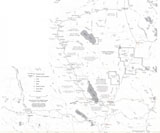The Lacombe and North Western Railway
Financial difficulties led to delays in the start of construction but eventually, with the help of government bond guarantees, grading was completed to mile 19 by 1914. With the onset of war work on the line ceased.1
Work was resumed in 1917 under the supervision of the government of Alberta that felt obliged to see the line completed to Bentley.2 This supervision was replaced by outright control in 1918 when the government acquired a majority of the stock and in 1919 changed the name of the company to The Lacombe and North Western Railway (L&NWR).3 Rimbey was reached in that year,4 followed by the extension to Bluffton in 1920.5
In 1921 the act of incorporation was amended to allow the railway to be extended by the west end of Pigeon Lake and north-easterly to Edmonton.6 The following year freight and passenger service was inaugurated to Hoadley and by 1926 the line had been laid into Breton.7 Though relying on steam locomotives, the L&NWR did use a gasoline hydraulic rail car that was scrapped in 1928.8 A similar type of car was used for excursion purposes to Aspen Beach in 1921 with limited success.9
During the 1920s the government tried to sell the railway because it had become a financial burden with operating deficits far outweighing operating surpluses, and interest charges of about $81,000 annually.10 Relief came when the Canadian Pacific Railway agreed to purchase the L&NWR for $1,500,000 “and to indemnify the Province against future liability on outstanding five percent bonds of $273,700.”11 The CPR also agreed to extend the line a further twenty miles within three years.12 Thus, the entire assets of the L&NWR were transferred to the CPR on March 1, 1928.13 Thorsby was reached in 1929 and then the line was extended to Leduc in 1931.14 The CPR was to benefit from the growing lumber industry between Hoadley and Warburg.
Though purchased by the CPR, the Lacombe and North Western Railway remained a separate corporate entity and as such was leased to the CPR for 999 years on July 1, 1929.15 The company was dissolved in 1957.16
Notes | Bibliography | Abbreviations
1. National Archives of Canada, RG30, Volume 7362, File 167–1, Canadian National Railways, Report on the Land NWR, Winnipeg, 1023.2. Alberta Department of Railways and Telephones, Annual Report, 1917.
3. Provincial Archives of Alberta, 83.488/3, Order in Council, 15 August 1918; Alberta, 9 George V, Chapter 29, 17 April 1919.
4. Annual Report, 1919.
5. Breton and District Historical Society, The Railroads in the Ladder of Time: A History of Breton and District ( Edmonton: 1980), p. 160.
6. 2 George V, Chapter 55, April 1921.
7. Annual Reports, 1922; 1926.
8. Canadian Railway and Marine World, November 1915; E. Schneider, “The Peanut Road,” Canadian Rail (May–June 1987): p. 76.
9. Ibid., p. 79.
10. Annual Report, 1928.
11. Ibid.
12. Ibid.
13. Ibid.
14. Canadian Railway and Marine World, January 1930; August 1931.
15. Dominion, P.C. 1861, 25 September 1929.
16. Omer Lavallée Personal Communication.


